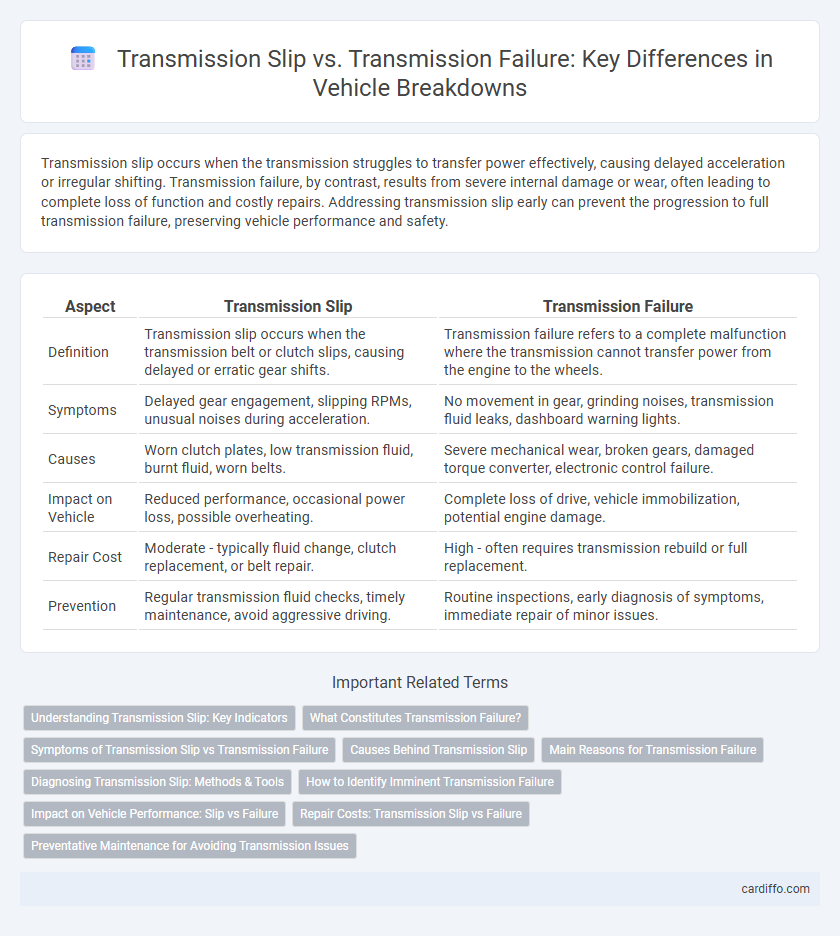Transmission slip occurs when the transmission struggles to transfer power effectively, causing delayed acceleration or irregular shifting. Transmission failure, by contrast, results from severe internal damage or wear, often leading to complete loss of function and costly repairs. Addressing transmission slip early can prevent the progression to full transmission failure, preserving vehicle performance and safety.
Table of Comparison
| Aspect | Transmission Slip | Transmission Failure |
|---|---|---|
| Definition | Transmission slip occurs when the transmission belt or clutch slips, causing delayed or erratic gear shifts. | Transmission failure refers to a complete malfunction where the transmission cannot transfer power from the engine to the wheels. |
| Symptoms | Delayed gear engagement, slipping RPMs, unusual noises during acceleration. | No movement in gear, grinding noises, transmission fluid leaks, dashboard warning lights. |
| Causes | Worn clutch plates, low transmission fluid, burnt fluid, worn belts. | Severe mechanical wear, broken gears, damaged torque converter, electronic control failure. |
| Impact on Vehicle | Reduced performance, occasional power loss, possible overheating. | Complete loss of drive, vehicle immobilization, potential engine damage. |
| Repair Cost | Moderate - typically fluid change, clutch replacement, or belt repair. | High - often requires transmission rebuild or full replacement. |
| Prevention | Regular transmission fluid checks, timely maintenance, avoid aggressive driving. | Routine inspections, early diagnosis of symptoms, immediate repair of minor issues. |
Understanding Transmission Slip: Key Indicators
Transmission slip occurs when the engine's power fails to transfer efficiently to the wheels, causing delayed acceleration and irregular RPM fluctuations. Key indicators include sudden hesitation during gear shifts, a burning smell from overheating clutch plates, and noticeable drops in vehicle speed despite increased engine effort. Recognizing these symptoms early helps differentiate transmission slip from complete transmission failure, enabling targeted maintenance and avoiding costly repairs.
What Constitutes Transmission Failure?
Transmission failure occurs when critical components like the clutch, torque converter, or gears suffer irreversible damage, leading to the inability to transfer power from the engine to the wheels effectively. Unlike transmission slip, which is characterized by delayed or erratic gear engagement due to worn or damaged components, transmission failure results in complete loss of drivability and requires extensive repair or replacement. Key indicators of transmission failure include grinding noises, burning smells, and a vehicle that refuses to move despite engine power.
Symptoms of Transmission Slip vs Transmission Failure
Transmission slip is characterized by delayed acceleration, unexpected changes in engine RPM without corresponding speed increase, and harsh or erratic shifting. Transmission failure typically presents with complete loss of power transmission, inability to engage gears, persistent warning lights, and unusual noises such as grinding or clunking. Identifying these specific symptoms helps differentiate between transmission slip and a total transmission failure for accurate diagnosis and timely repair.
Causes Behind Transmission Slip
Transmission slip occurs when the transmission system fails to properly engage gears, often caused by worn clutch plates, low transmission fluid levels, or damaged seals. These issues reduce the hydraulic pressure needed for smooth gear shifts, leading to slipping and loss of power transfer. Unlike complete transmission failure, slip typically signals early-stage wear or fluid contamination that, if ignored, can escalate to severe transmission damage.
Main Reasons for Transmission Failure
Transmission failure primarily results from severe internal component wear, such as damaged gears, broken clutches, or a malfunctioning torque converter. Inadequate or contaminated transmission fluid leads to overheating and insufficient lubrication, accelerating mechanical breakdown. Neglecting routine maintenance also causes buildup of debris and corrosion, which impairs hydraulic systems and clogs transmission filters, culminating in total transmission failure.
Diagnosing Transmission Slip: Methods & Tools
Diagnosing transmission slip involves using specialized diagnostic tools such as OBD-II scanners to detect error codes related to transmission performance. Mechanics often perform a road test alongside monitoring live data streams of transmission fluid temperature, shift timing, and torque converter slip. Visual inspection of the transmission fluid for color, odor, and contamination further aids in distinguishing transmission slip from total transmission failure.
How to Identify Imminent Transmission Failure
Warning signs of imminent transmission failure include slipping gears, delayed or rough shifting, and unusual noises such as whining or clunking from the transmission. A burning smell, low transmission fluid levels, or dark, dirty fluid can also indicate serious problems. Early detection through these indicators allows timely repairs, preventing complete transmission breakdown and costly replacements.
Impact on Vehicle Performance: Slip vs Failure
Transmission slip causes delayed acceleration and erratic shifting, reducing overall vehicle responsiveness and fuel efficiency. In contrast, transmission failure results in a complete loss of power transfer, immobilizing the vehicle and necessitating immediate repair or replacement. Slip often signals early wear or fluid issues, while failure indicates severe internal damage compromising drivability.
Repair Costs: Transmission Slip vs Failure
Transmission slip often results in lower repair costs, typically ranging from $1,000 to $3,000, as it may involve clutch adjustments or fluid replacement. Transmission failure usually demands extensive repairs or a full rebuild, with expenses soaring between $3,000 and $7,000 or more. Early diagnosis of transmission slip can prevent costly failures and reduce overall maintenance expenses.
Preventative Maintenance for Avoiding Transmission Issues
Transmission slip often signals early wear in the clutch or bands, requiring timely fluid checks and adjustments to prevent further damage. Transmission failure occurs when internal components seize or break, often due to neglecting routine maintenance like fluid replacement and filter cleaning. Regularly scheduled inspections and maintenance can significantly reduce the risk of costly transmission repairs and extend vehicle lifespan.
Transmission slip vs transmission failure Infographic

 cardiffo.com
cardiffo.com